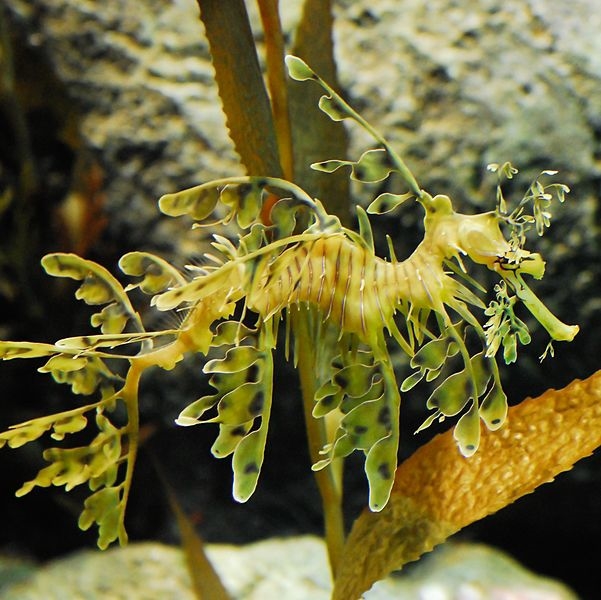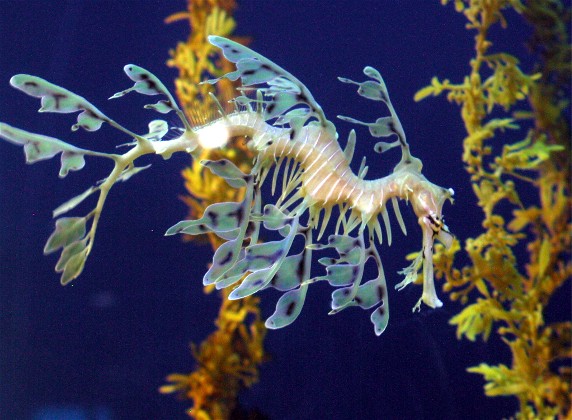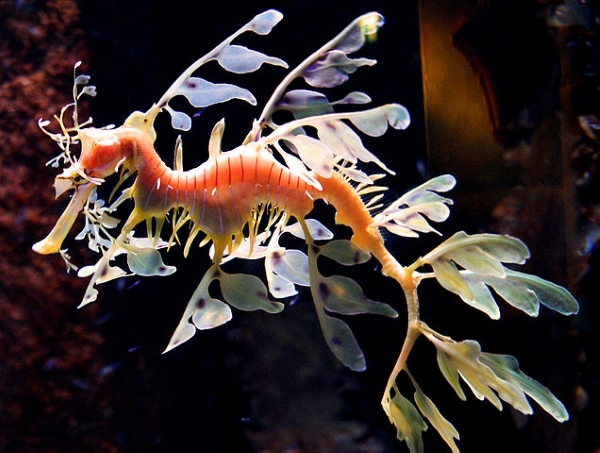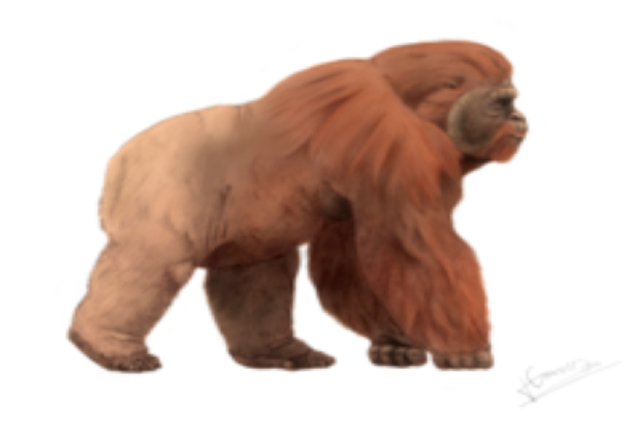
The leafy sea dragon, also known as Phycodurus eques, is a spectacular-looking fish that is found in the waters of southern Australia. It uses its specific leafy appearance for camouflage, as it resembles seaweed. Its near-perfect camouflage makes it hard to spot it in its natural habitat. Besides resembling seaweed, the leafy dragon can also change colors and its movement can be easily confused to that of a floating weed.
While it is extremely hard to spot it in the wild, it is not easy to see it in zoos either as the leafy sea dragon is displayed in just a handful of zoos in the USA and Australia.
The leafy sea dragon and its “common” cousin, the weedy sea dragon, are long, slender fish with bony plates surrounding their bodies. They grow to less than 30cm and feed on plankton and smaller crustaceans.
Leafy sea dragons have an interesting way of moving, though they scarcely appear to move at all. The creature steers and makes the occasional turn by panning its tiny, translucent fins along the sides of the head. At a glance, you could mistake a leafy for a sponge or seaweed.
In many aspects, like reproduction, they resemble the behavior of their relatives, the sea horse. The eggs produced by the female are placed on the male sea dragon’s tail where they will stay for nine weeks until they hatch. To assist hatching the male will rub its tail against rocks. Leafy dragons are independent right after they are born, feeding on zooplanktons.
Endangered character of the leafy sea dragon
The leafy sea dragon is an endangered cousin of the sea horse native to the waters of Tasmania, Australia. So far no kind of fish has been classified as endangered in Australia – simply because nobody can be sure how many there are.
Officially they are near threatened, but that is partly because it is hard to assess their population. Practically, leafy sea dragons are exposed to many dangers.

Leafy sea dragons, ornate and beautiful denizens of the southern Australian coastline, are certainly at risk as worldwide, a booming trade in syngnathid (pipefish and seahorse) species for Chinese medicine, aphrodisiacs and the seafood and aquarium trades is devouring up to 10 million a year.
Australia’s beautiful leafy sea dragon is especially vulnerable because it can fetch $12,000 or more on the global black market.
Being passive, the leafy is readily caught once a diver has spotted it although its superb camouflage makes this a difficult feat in itself.
Collecting it is illegal without a permit in both Western Australia and South Australia.
Apart from being traded illegally, the leafy sea dragon is affected by other issues as well. Sea dragons are dying off because the seagrasses in which they live have disappeared from the coastline.
Seagrass loss is largely blamed on nutrients entering the marine environment from stormwater and sewage outlets.
Besides its tourism potential, the leafy is important for another reason: it is pioneering the idea that imperiled fish should be protected in the same way as vulnerable marine animals such as whales, turtles and dugongs.

Interesting Facts
The leafy sea dragons along with its relative, the weedy sea dragon are some of the most intriguing sea creatures that live in waters near Australia. Some of the interesting facts about the leafy dragon can be found below:
- They are hard to spot in zoos as well: less than ten zoos and aquariums worldwide display leafy sea dragons.
- They grow to a length of maximum 18 inches.
- They eat the planktons and sea lice by sucking it up with its snout and small mouth.
- They move slowly and are mostly static. At maximum, it was recorded that they move 150 meters an hour.
- Their movement is realized with small pectoral and dorsal fins. For camouflage purposes, these fins are transparent.
- As is the case with seahorses, the leafy sea dragon male is the one who will care for eggs.
- Only around 5% of the eggs will hatch and survive.
- Despite its name, it is nonviolent, except if you are a plankton.
- Since 2001 the marine emblem of South Australia has been the leafy sea dragon. It was adopted by the government on February 8, 2001.
- A relative of the seahorse, the leafy sea dragon belongs to the pipefish family Sygnathidae.
- It is one of only two species of sea dragons in southern Australia, the other being the weedy sea dragon (Phyllopteryx taeniolatus).
- The weedy sea dragon, looks much more like a dragon, with its red body, yellow marks and stripes and tube-shaped snout.
Leafy Sea Dragon Habitat
The leafy sea dragon’s distribution is centered on South Australia coastal waters, ranging from Geraldton in Western Australia, to the north of Perth, along the southern Australian coastline, to Wilsons Promontory in Victoria. The sea dragon is a protected species in this state’s waters.
They can be found next to sand patches, rocky reefs and sea weed. They do not travel to long distances from their location as they can stay up to 68 hours in the same spot. They don’t travel to lengthy distances from their natural habitat and they will come back to their original place.
Just like other Australian animals, like the platypus, who are rarely seen by humans, spotting a leafy sea dragon in its natural habitat is a very daunting task because it blends perfectly in its habitat.
In captivity, it is found only in a handful of zoos around the world, mainly in Australia and the United States.


